What is MSIX Packaging Tool and how does it work?
When you open the MSIX Packaging Tool, you are greeted with a simple interface. Next to the settings button in the upper right corner, you will see the following three features presented as actions:
- Application package → Create standalone MSIX package
- Modification package → Already have MSIX and need to make modification package
- Package editor → Edit an existing package

Let's take a closer look at each individual task to see if it fits your needs and how it works.
1. Application package
Here is the script that starts when creating the MSIX package. As required, you will need the base application repackaged as an MSIX and a certificate. Remember, all MSIX packages must be digitally signed.
Step 1: Choose the environment
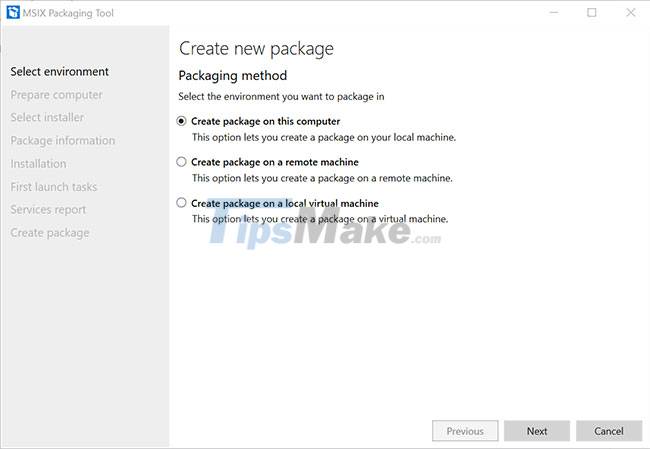
Regardless of which option you choose, it is best to create the package on a 'clean' computer, similar to the one you are using to deploy the application. This helps to avoid compatibility issues.
Many people prefer to run the process in a virtual machine where the MSIX Packaging Tool is installed to avoid possible communication and configuration issues between machines.
Step 2: Prepare the computer
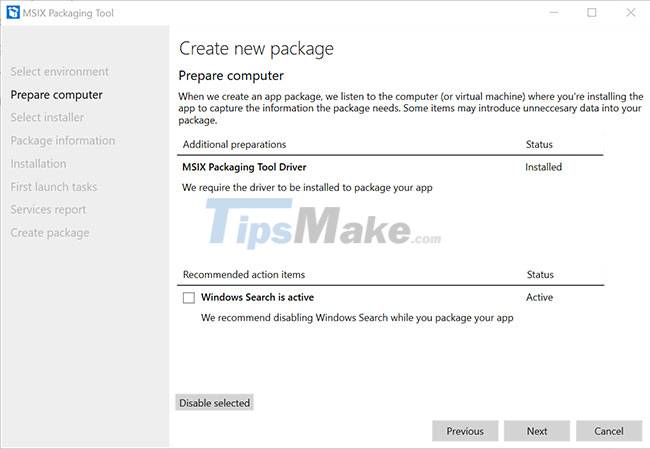
MSIX Packaging Tool has a launch detection method before starting the repackaging process. It detects if the required Tool Driver is installed and if there are any services, pending reboots or other interfering items that are active and need to be shut down.
Step 3: Select the installer
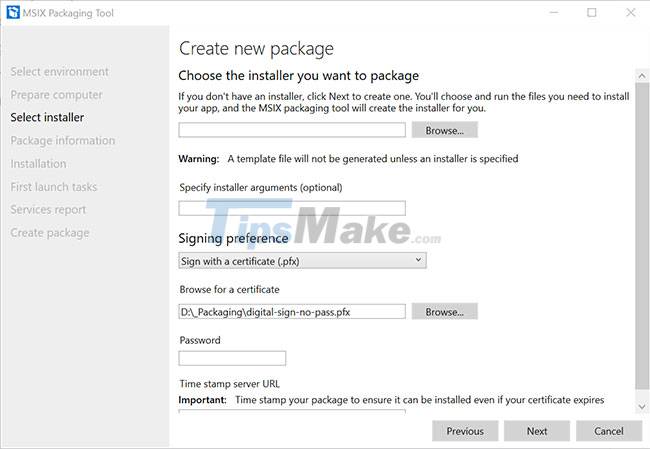
In the Select Installer step, you will browse for your base application installer and specify the installation arguments as needed. Since the MSIX Packaging Tool works like a repackager, it also allows you to create a package without an installer, by adding files and operations that run on the operating system during the process.
Also, an important step here is to define the signing method and actually sign the package. This is important, as every MSIX package must be digitally signed. No exception.
The packager will take two snapshots. One before and one after you install the application or make any modifications in the operating system (i.e. copy files, run executables, etc.). Finally, it will compare the two snapshots and the result will be the MSIX package.
To assist users, Microsoft has created a best practice guide for repackaging an application using the MSIX Packaging Tool. Readers can refer here.
Step 4: Package Information
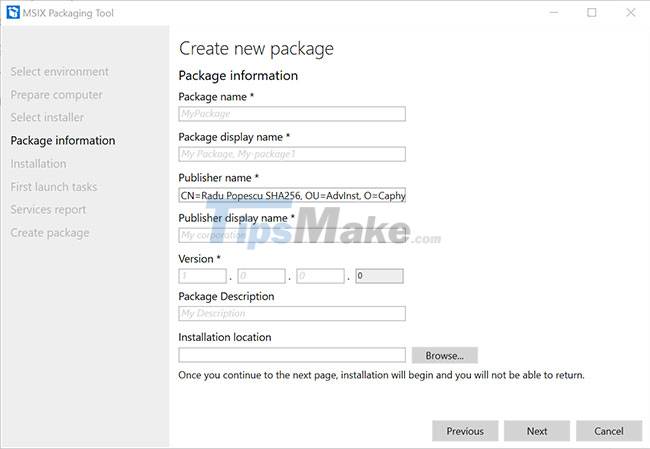
You will add package information in this step. You will also notice that "Publisher name" is pre-populated as it automatically pulls the information from the certificate.
Step 5: Install
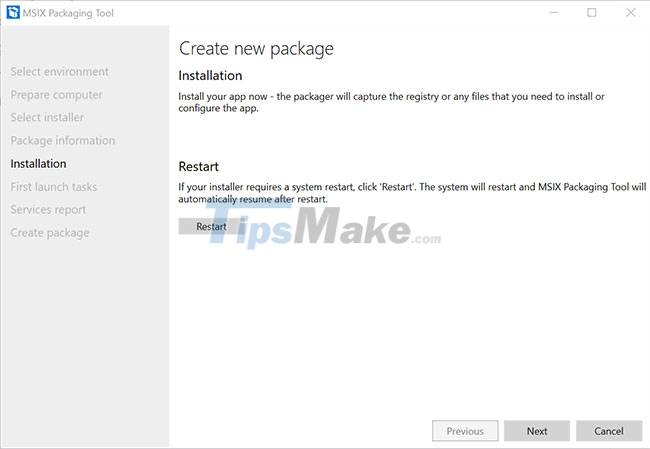
When it comes to the installation step, you can run the installation wizard of the base application or manually perform the operations you need, such as copying, moving, deleting or configuring files, etc. Click Click Next when you're done.
Step 6: Launch the first task
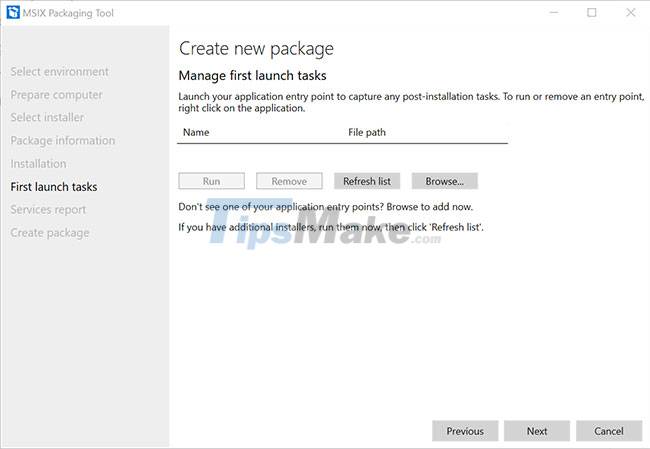
The MSIX Packaging Tool will attempt to detect the entry point(s) of the application. Many shortcut items will need to use PSF.
At the end of this step, the MSIX Packaging Tool will take a second snapshot. Note that the initial snapshot is taken immediately after the second step, when the tool detects any activity that interferes with the repackaging process.
Step 7: Report service
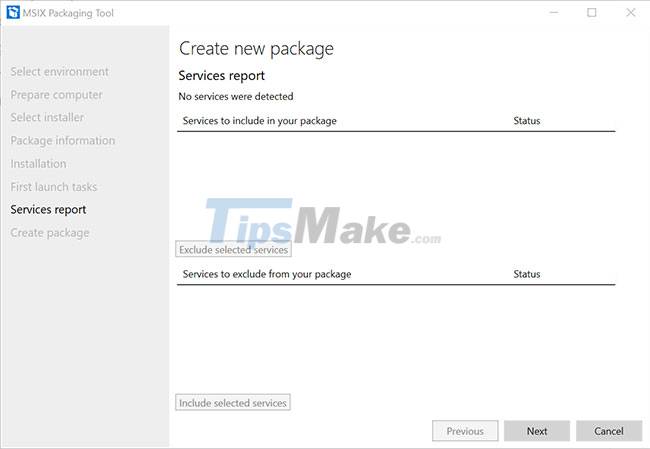
If your application has any services, they will be listed here. Remember: MSIX services will run outside of the container, that's why they are treated separately.
Step 8. Create the package
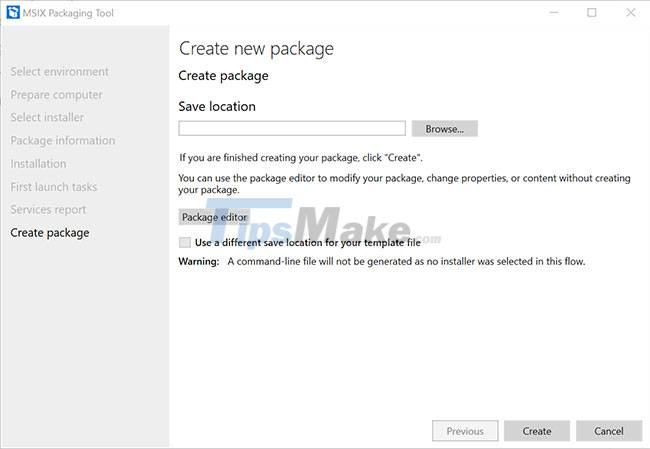
Last but not least, just use the Browse button to select the location where you want to save the package.
2. Modification package (modification package)
Let's say you have deployed an MSIX package and need to create a custom package for it, or in other words create a 'patch'. To do this, you will need to create a modified package.

You can observe a lot of similarities when packaging and modifying packages.
The main difference here is that in the installer selection step (3rd step) you need to provide the main MSIX package as a reference. The package information will be extracted from there.
However, if you do not want to provide MSIX before or do not have access to the source files, you can skip adding the referenced package and enter the information manually.
The article recommends that you always provide the main MSIX. This way you will avoid any typos that could lead to packet repetition and wasted time.
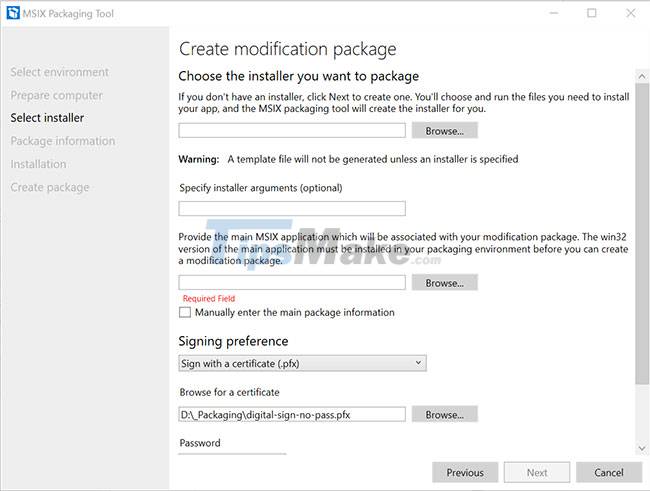
As mentioned above, the remaining steps are similar to a simple application packaging process. Follow the stated steps to complete the modified package.
3. Package editor (package editor)
Once you've got an MSIX package and all you want to do is make a quick edit, this option does the job for you. Browse through the package and you will have access to the details inside.
Package information
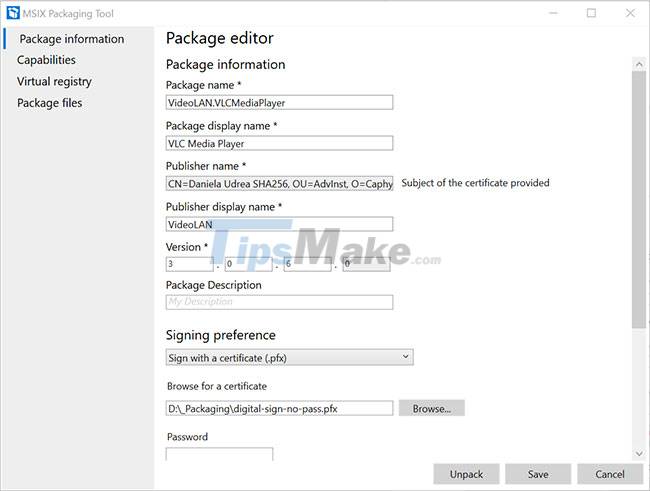
- Modify any package information
- Sign the package with another certificate
- Edit manifest.xml
Package editor
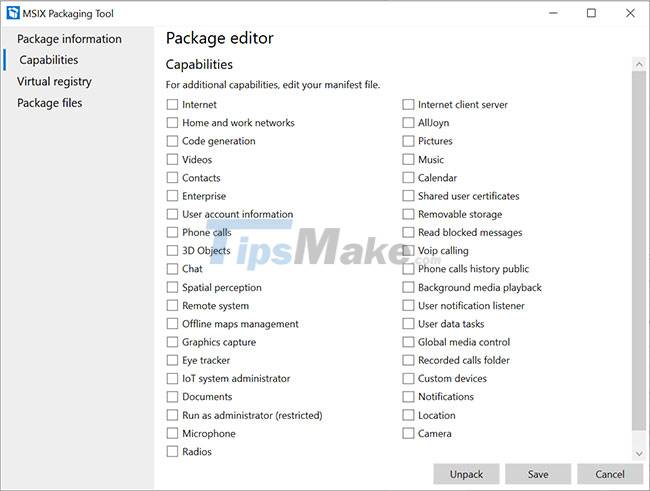
- Add any capabilities your MSIX may require
- Additional unlisted capabilities can be added to the manifest
Virtual registry
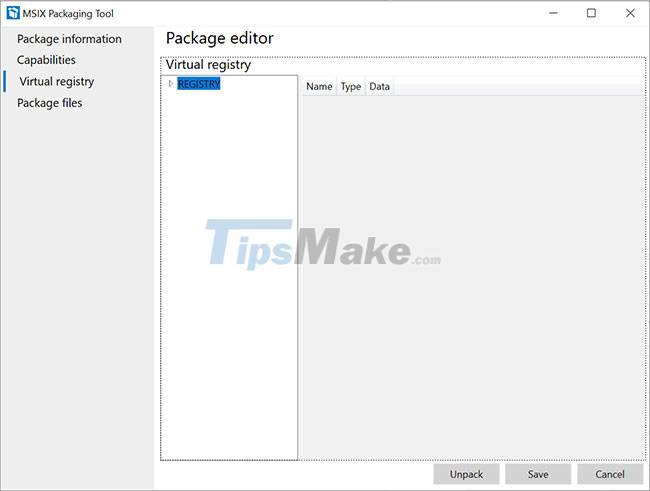
- Browse and edit your computer's hive registry
- Browse and edit the user's hive registry
- Remember that these are stored registry
Package files
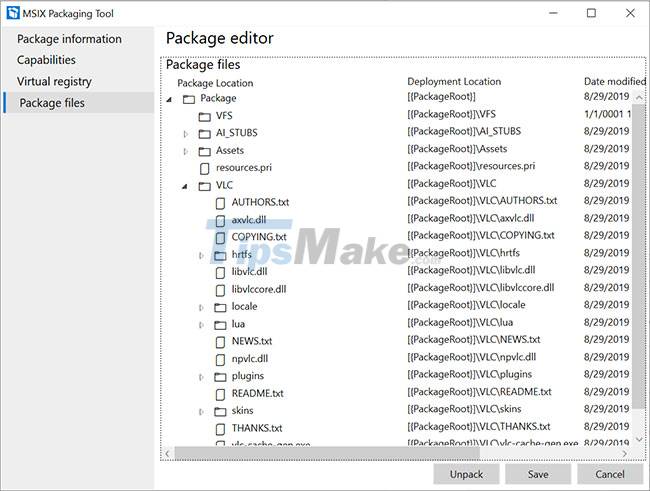
- Add, move, delete files
- Add, move, delete folders
Besides, you can also have the option to extract the MSIX package to a specified output location.
You should read it
- Learn about FlipChip technology
- About the Paint Tool SAI tool
- How to use Snipping Tool on Windows 10 full set
- Coronavirus unemployment: Everything you need to know about payments, applying and more
- Microsoft allows users to reactivate Windows App installer
- USB-IF announces new list of USB-C logos, making it easier to choose a charging cable
- Snipping Tool cannot be used, summarize effective ways to fix it
- Coreldraw 12 - Lesson 8: Spiral drawing tool
May be interested
- Coronavirus unemployment: Everything you need to know about payments, applying and more
 if you've never lost a job or been furloughed, the covid-19 outbreak might have changed that for you.
if you've never lost a job or been furloughed, the covid-19 outbreak might have changed that for you. - How to use Snipping Tool on Windows 10 full set
 tipsmake.com will introduce you to read a sophisticated screen capture tool - that's snipping tool. the article will show you how to take a screenshot, how to edit, save and email screenshot and how to use the available bookmarking tools and how to change the settings of snipping tool.
tipsmake.com will introduce you to read a sophisticated screen capture tool - that's snipping tool. the article will show you how to take a screenshot, how to edit, save and email screenshot and how to use the available bookmarking tools and how to change the settings of snipping tool. - How to use Microsoft Teams to work remotely?
 microsoft team is an online communication tool with high security and is trusted by users. along with today's article, tipsmake.com will guide you how to use microsoft team to be able to work in remote groups.
microsoft team is an online communication tool with high security and is trusted by users. along with today's article, tipsmake.com will guide you how to use microsoft team to be able to work in remote groups. - Microsoft allows users to reactivate Windows App installer
 microsoft has just allowed enterprise administrators to re-enable the msix ms-appinstaller protocol handler. windows app installer used to be disabled to avoid being abused by the emotet malware.
microsoft has just allowed enterprise administrators to re-enable the msix ms-appinstaller protocol handler. windows app installer used to be disabled to avoid being abused by the emotet malware. - One of the best applications for Windows 10 is available on the Windows Store
 while snipping tool and prntscr work for most users, they are not the best tool for professional users. recently, microsoft has introduced the best screen capture tool for windows 10 - that's sharex.
while snipping tool and prntscr work for most users, they are not the best tool for professional users. recently, microsoft has introduced the best screen capture tool for windows 10 - that's sharex. - 5 effective ways to help you work smarter
 not to work hard to be effective, it is important to know how to work smartly.
not to work hard to be effective, it is important to know how to work smartly. - USB-IF announces new list of USB-C logos, making it easier to choose a charging cable
 these new logo templates will be printed directly on the packaging of licensed usb-c chargers and cables from usb-if.
these new logo templates will be printed directly on the packaging of licensed usb-c chargers and cables from usb-if. - Invite you to create 3D faces only from a quick photo with this AI
 if you are bored because it is too early in the work or work week, this simple little ai tool will bring some joy.
if you are bored because it is too early in the work or work week, this simple little ai tool will bring some joy. - How to find meaning in work and work happily?
 perfect work always makes you feel satisfied and meaningful is probably quite a bit of a mess. so how to find meaning in work and work happily? let's tipsmake.com find out!
perfect work always makes you feel satisfied and meaningful is probably quite a bit of a mess. so how to find meaning in work and work happily? let's tipsmake.com find out! - Coronavirus stimulus check is official: Find out if you're eligible for up to $1,200
 the new coronavirus relief package includes cash payments to many people affected by the epidemic. here's what you need to know.
the new coronavirus relief package includes cash payments to many people affected by the epidemic. here's what you need to know.










 What is Winload.exe? learn about Winload.exe
What is Winload.exe? learn about Winload.exe How dangerous is IP address exposure?
How dangerous is IP address exposure? What is Microsoft Management Console (MMC)? Steps to use Microsoft Management Console
What is Microsoft Management Console (MMC)? Steps to use Microsoft Management Console Learn Huawei's harmonyos 2.0 operating system
Learn Huawei's harmonyos 2.0 operating system What is the Apple Center Stage feature? What is the effect?
What is the Apple Center Stage feature? What is the effect? What is WPA2 (WiFi Protected Access 2)?
What is WPA2 (WiFi Protected Access 2)?